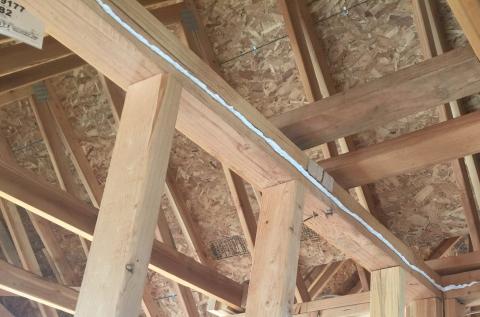Ceiling cracks running diagonally across ceiling.
Cracks in drywall seams after attic renovation.
Some drywall mud has more adhering ability and should be used when taping drywall whereas other types of drywall mud should only be used in finishing.
Usually the seams are invisible due to the use of drywall mud and tape.
A crack a 16th of an inch or larger that runs at a diagonal angle through a sheet s of drywall requires a lot of force to create this crack.
The mud fills in the seam and the tape covers it up.
Some drywall mud products are intended only for second or third coats.
If you ve got thin cracks in your drywall you don t necessarily have to break out the drywall compound to mud the area.
One reason drywall cracks is because the wrong type of drywall mud was used when taping the seams.
This type of crack generally would be considered a red flag depending on width length and location.
This article describes the common causes of all types of cracks that appear in drywall or gypsum board or plasterboard walls ceilings in building interiors.
These joint areas are weaker than in the center or field area of the drywall therefore some cracks may occur at these joints.
In fact you can save time and money on your home renovation by caulking drywall corners in areas like closets laundry rooms and mudrooms.
Additionally drywall cracks are often found where two pieces of drywall are butted together.
This occurs because there is a joint which gets drywall taped and then layered with two or three coats of drywall mud.
Drywall cracks in ceilings or walls.
When a crack appears it is usually on a seam where two drywall sheets meet and it is easily fixed.
Cracks in your drywall or plaster interior walls could be the result of your house settling which could come from the foundation or may be the result of earth movement according to gregg cantor.
This involves scraping away the loose tape and crumbled bits of drywall mud sanding the surface smooth.
If the crack is on a vertical or horizontal seam carefully widen the crack with the corner of a paint scraper utility knife or chisel to determine if the crack extends completely through the paper that is covering the seam image 1.
Repairing cracks in walls the best way to repair a crack in drywall is to re tape the joint.
Most drywall cracks occur on the seams where two pieces of drywall meet.
Illustrations show where cracks are most likely to appear explain why and suggest both repair approaches to drywall cracks and how to prevent cracking in plasterboard or gypsum board.
House settling and temperature or moisture fluctuations in an attic which result in the expansion or contraction of framing members.

